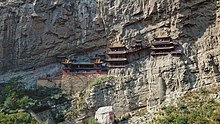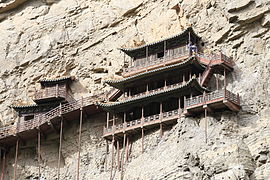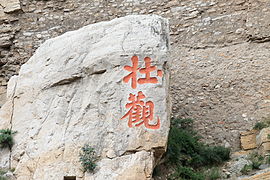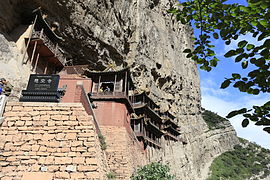Hanging Temple
| Hanging Temple | |
|---|---|
悬空寺 | |
 The Hanging Temple. | |
| Religion | |
| Affiliation | Buddhism |
| Location | |
| Location | Hunyuan County, Datong City, Shanxi Province |
| Country | China |
| Geographic coordinates | 39°39′57″N 113°42′18″E / 39.66583°N 113.70500°E |
| Architecture | |
| Style | Chinese architecture |
| Founder | Liaoran |
| Date established | 6th century |
The Hanging Temple, also Hengshan Hanging Temple, Hanging Monastery or Xuankong Temple (simplified Chinese: 悬空寺; traditional Chinese: 懸空寺; pinyin: Xuánkōng Sì) is a temple built into a cliff (75 m or 246 ft above the ground) near Mount Heng in Hunyuan County, Datong City, Shanxi Province, China. The closest city is Datong, 64 kilometres (40 mi) to the northwest. Along with the Yungang Grottoes, the Hanging Temple is one of the main tourist attractions and historical sites in the Datong area. Built more than 1,500 years ago, this temple is notable not only for its location on a sheer precipice but also because as a Buddhist temple it also contains references to the other two of the three Chinese traditional philosophies or religions (三教): Taoism, and Confucianism. The structure is kept in place with oak crossbeams fitted into holes chiseled into the cliffs. The main supportive structure is hidden inside the bedrock.[1] The monastery is located in the small canyon basin, and the body of the building hangs from the middle of the cliff under the prominent summit, protecting the temple from rain erosion and sunlight bake.
History
According to legend, construction of the temple was started at the end of the Northern Wei dynasty by only one man, a monk named Liaoran (了然) in 491 AD. Over the next 1,400 years, many repairs and extensions have led to its present-day scale.[2]
Overview
The entire 40 halls and pavilions are all built on cliffs which are over 30 metres (98 ft) from the ground. The distance from north to south is longer than from east to west and it becomes higher and higher from the gate in the south to north along the mountain. The temple can be divided into a northern and southern section.
Northern section
The northern section contains:[3]
- Wufo Hall - The Hall of the Five Tathagatas
- Guanyin Hall - Hall of the bodhisattva Guanyin
- Hall of Three Religions (三教殿). The Hall of Three Religions mainly enshrines Buddhist deities as well as both Taoism and Confucianism. The statues of Śakyamuni (middle), Lao-Tze (left) and Confucius (right) are enshrined in the hall. This reflects the prevailing idea of "Three Teaching Harmonious as One" (三教合流) in the Ming and Qing dynasties (1368–1911).[3]
Southern section
The southern part has three floors, it contains the following halls:[3]
- Chunyang Palace - for worshiping Lü Dongbin - one of the Eight Immortals of Taoism
- Sanguan Hall (Hall of the Three Officials, 三官殿) - the largest hall in the temple, in which the "Three Great Emperor-Officials" (the officials of Heaven, Earth and Water) are worshiped with Ming era clay sculptures.
- Leiyin Hall (Thunder Hall) - A Buddhist hall dedicated to Buddha Śakyamuni located at the top of the southern section.
Gallery
References
- ^ "挂在60米高悬崖上 千年古寺为何悬空不倒". Archived from the original on 2013-04-06. Retrieved 2011-02-13.
- ^ Brenhouse, Hillary (9 June 2010). "Xuan Kong Si, Shanxi Province, China". Top 10 Precarious Buildings. Time.com. Archived from the original on June 12, 2010. Retrieved 31 March 2011.
- ^ a b c Zi Yan (2012). Famous Temples in China (in English and Chinese). Hefei, Anhui: Huangshan Publishing House. pp. 67–68. ISBN 978-7-5461-3146-7.
External links
- Hanging Temple, Class II Protected Sites in China, from ChinaCulture.org. Retrieved d.d. January 1, 2010.
- History of the Hanging Monastery
- Geo Architecture and Landscape in China's geographic and Historic Context (2016). Book by Fang Wang. Page 102-112.




















